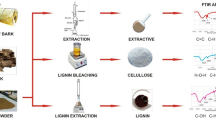Abstract
The process of thermal degradation of lignins of hard wood (birch, aspen, oak), obtained under the wood treatment with 66% sulphuric acid in the form of acid-in-soluble and soluble fractions, has been investigated by thermal methods. Activation energy values of lignin pyrolysis have been determined at the stage of increasing rate of weight loss. It has been established that the difference in their thermal properties is conditioned by the structural changes in the process of isolation from wood. It has been suggested that acid-soluble lignins have a higher density than acid-insoluble ones. Sulphuric acid lignins of birch, in particular acid-soluble lignin, are assumed to possess a more homogeneous structure than sulphuric acid lignins of other species
Résumé
On a fait l'étude par ATD du processus de la dégradation thermique des lignines de bois durs (chêne, bouleau,) obtenues sous forme de fractions solubles et insolubles dans l'acide sulfurique à 66% utilisé pour traiter le bois. On a déterminé les valeurs des énergies d'activation au moment oú la vitesse de perte de poids augmentait. On a montré que les différences observées dans leurs propriétés thermiques étaient une conséquence des changements de structure provoqués pendant le traitement du bois. On a établi que les lignines solubles dans l'acide ont une structure plus dense que celles qui sont insolubles. Les lignines de bouleau isolées par l'acide sulfurique, surtout celles qui sont solubles, montrent une structure plus homogène que les lignines obtenues de manière comparable avec d'autres espèces.
Zusammenfassung
Die thermische Zersetzung von Ligninen aus Hartholz (Eiche, Beberesche, Birke), erhalten in Form von säurelöslichen und unlöslichen Fraktionen der Holzbehandlung mit 66%iger Schwefelsäure, wurde thermoanalytisch untersucht. Die Werte der Aktivierungsenergie der Ligninpyrolyse wurden bei zunehmenden Gewichtsverlustgeschwindigkeiten bestimmt. Es wurde gefunden, daß die Unterschiede ihrer thermischen Eigenschaften auf die während der Abtrennung aus dem Holz erlittenen strukturellen Änderungen zurückzuführen sind.
Säurelösliche Lignine besitzen einen höheren Grad von Densität als säureunlösliche. Schwefelsä urelignine von Birke, besonders die säurelöslichen, zeigen bedeutend homogänere Struktur als die Schwefelsäurelignine anderer Sorten.
Резюме
Термическим методом исследован процесс термораспада лигнин ов, выделенных обработкой лиственн ых пород древесины (бе реза, осина, дуб) 66%-ной серной кисло той в форме кислотораств оримой и кислотонера створимой фракций. Значения эне ргии активации пиролиза л игнина определены на стадии возрастающей скорос ти потери веса. Установлено, что разн ица в термических сво йствах этих фракций лигнинов обу словлена изменениями их струк тур в процессе выделе ния из древесины. Предполаг ается, что кислоторас творимые лигнины имеют более у плотненную структур у, чем кислотонерастворим ые. Сернокислые лигнины березы, особенно кислоторастворимый лигнин, обладают знач ительно более высокой степен ью гомогенности, чем сернокислотные лигн ины других пород.
Similar content being viewed by others
References
G. E. Domburg andV. N. Sergeeva, Chimija drevesiny, 1 (1968) 75.
F. Paulik, J. Paulik, L. Erdey, Z. anal. Chem., 160 (1958) 241.
H. H. Horovitz, G. Metzger, Anal. Chem., 35 (1963) 1465.
G. E. Domburg, V. N. Sergeeva, M. F. Koshik, L. J. Salna, Izvestija AN Latv. SSR, serija chim., 4 (1968) 497.
G. E.Domburg, V. N.Sergeeva, M. F.Koshik, Chimija drevesiny, 4 (1969) (in the press).
A. J. Stamm, Ind. and Eng. Chem., 48 (1956) 413.
B. Solomon, G. Rozmarin, A. Biro, Gr. Simonescu, Cellulose Chemistry and Technology, 1 (1967) 601.
M. Koshik, L. Geratova, F. Rendosh, R. Domansky, Holzforschung und Holzverwertung, 20 (1968) 15.
A. Tomek, G. Liptay, J. Simon, L. Erdey, Holz als Roh- und Werkstoff, 26 (1968) 45.
G. F.Prokshin, B. D.Bogomolov, G. E.Domburg, Chimija drevesiny, 4 (1969) (in the press).
Author information
Authors and Affiliations
Additional information
Thanks are due to O. M. Sokolov, G. G. Kochergina, N. D. Babikova (Forest Technical Institute, Archangelsk) for their assistance in the determination of molecular weight distribution of lignins.
Rights and permissions
About this article
Cite this article
Domburg, G.E., Sergeeva, V.N. Thermal degradation of sulphuric acid lignins of hard wood. Journal of Thermal Analysis 1, 53–62 (1969). https://doi.org/10.1007/BF01911246
Received:
Issue Date:
DOI: https://doi.org/10.1007/BF01911246




